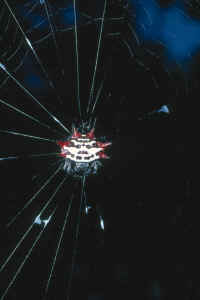
Wild Flowers and Their Associates Photos 021-040
A click on the number of a photo produces an enlargement to 800 by 600 pixels. A click on a photo produces a smaller enlargement.
Photo 021. Gasteracantha cancriformis hanging head downward in its web (South Florida). The spider includes tufts of silk in its web; presumably this attracts the attention of flying insects and promotes their ensnarement.
Photo 022. Micrathena sagittata from the Gumbo Limbo trail in the Everglades. This species of spider is the third of those with spines that I have encountered. That makes their identification easy (based on Professor Comstock's Spider Book) because very few species of spiders have such spines.
Photo 023. Micrathena sagittata with better perspective for its web.
Photo 024. Miranda aurantia (Comstock, pp. 448-452 ) photographed on a blue examination booklet. On April 5, 2010, I learned from John and Jane Balaban that the currently approved name is Argiope aurantia. John and Jane offer expertise to a website called BugGuide.net.
Photo 025. Miranda aurantia (Comstock, pp. 448-452 ) has been given the common names: the "Orange Garden Spider", the "Black and Yellow Garden Spider", and the "Writing Spider" . The female shown here is a large orb-weaving spider. Its web is frequently found constructed close to the ground in grassy fields in late summer and early autumn when grasshoppers are abundant. From the time a grasshopper lands in its web, it takes the spider just a few seconds to wrap the grasshopper in a shroud of silk and store it for later consumption. To illustrate how different names have been used, B. J. Kaston in "The Spiders ," William Brown Col. Publishers, Dubuque, Iowa, Second Edition, 1972, refers on page 172 to this spider as Argiope aurantia.
Photo 026. Metargiope trifasciata (Comstock, pages 452-254) is known as the Banded Garden Spider. The female photographed here is relaxing on a blue examination booklet. The habits of the Banded Garden Spider are similar to those of Miranda aurantia. On April 5, 2010, John and Jane Balaban mentioned that the approved name for this species in the World Spider Catalog is Argiope trifasciata.
Photo 027. This Banded Garden Spider in its web with natural lighting was photographed during late summer in my back yard before that area become a parking lot for football games.
Photo 028. This is an orb weaving spider common about gardens and shrubbery near houses in the Cincinnati area. I had believed it to be Neoscona benjamina (Comstock, p. 511). However, thanks to John and Jane Balaban, it should be labeled Neoscona crucifera.
Photo 029. The spider of Photo 028 in its web.
Photo 030. A male orb-weaving spider that has not been identified with certainty.
Photo 031. Aranea gigas var. conspicellata (Comstock, pp. 489-492) from the woods in my back yard before its destruction to become a parking lot. That name was my best guess. The name of Araneus marmoreus is the one that John and Jane Balaban have kindly supplied. (The parking lot in question is now occupied by the attractively-designed Beechwood Elementary School.)
Photo 032. Aranea gigas var. conspicellata (Comstock, pp. 489-492) from the woods in my back yard before its destruction.
Photo 033. Aranea gigas var. conspicellata (Comstock, pp. 489-492) from the woods in my back yard during the summer of 1969.
Photo 034. Aranea trifolium (Comstock, pp. 493-498) is commonly named the Shamrock Spider. She is a rather large orb-weaver. Courtesy of John and Jane Balaban on April 5, 2010, the current name is Araneus trifolium.
Photo 035. Aranea trifolium (Comstock, pp. 493-498). For better detail, she was carefully placed on a blue examination booklet before being returned to her web.
Photo 036. This female spider is believed to be Aranea sericata (Comstock, pp. 500-501), the Gray Cross Spider. For better detail, she was photographed on a blue examination booklet before being returned to her web. In B. J. Kasten's book "The Spiders," second edition, the corresponding name given on page 167 is Araneus sericatus.
Photo 037. Verrucosa arenata (Comstock, pp. 479-480) on a blue examination booklet. This webs of this species of orb-weaving spider were common along trails at the Lloyd Forest near Crittendon, Kentucky during July of 1969. But, webs of Micrathena gracilis (in Photos 17-18) were two to three times more numerous.
Photo 038. Verucosa arenata in her web at the Lloyd Forest during July of 1969
Photo 039. Hentzia basilica (Comstock, pp. 431-432) from South Florida during December of 1969. Those who have seen a spider of this species spin its web indicate that it first produces a horizontal orb having more than 50 radii; then it attaches numerous silk threads to the outer portions of the orb, pulls them downward, and anchors them; finally it connects numerous silk threads to the more central parts of the orb, pulls them upward, and fastens them. The appearance of the final dome-shaped web with the supporting lines led to Basilica Spider as its common name. On April 5, 2010, I learned from John and Jane Balaban that this spider is now named Mecynogea lemniscata.
Photo 040. Hentzia basilica in Florida during December of 1969.
Return to starting page for Wild Flowers and Their Associates